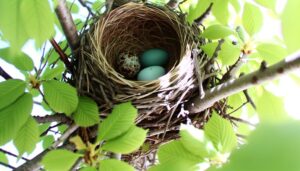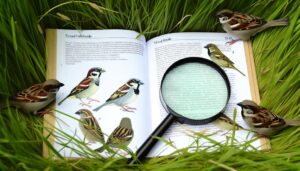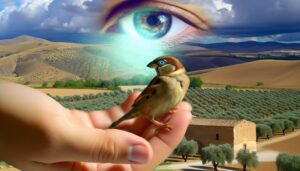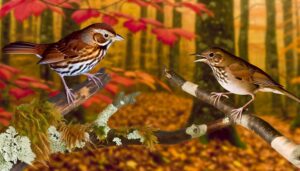Field Guide Tips: 7 Essentials for Sparrow Observation
A field guide to sparrows will detail their physical attributes such as stout bodies, strong beaks, and unique vocalizations. Sparrows are distinctive, inhabiting urban neighborhoods, farmlands, and forests globally, barring Polar Regions.
They display intricate behaviors, using diverse materials for constructing their nests, and displaying resilience in undertaking long, seasonal migrations. From the adaptable house sparrow to the melodious song sparrow, each species has its unique traits and behaviors that niche enthusiasts could explore.
Conservation efforts to counter threats like habitat destruction and pollution are hinted too. There's a wealth of sparrow knowledge to immerse oneself in, just a scroll away.
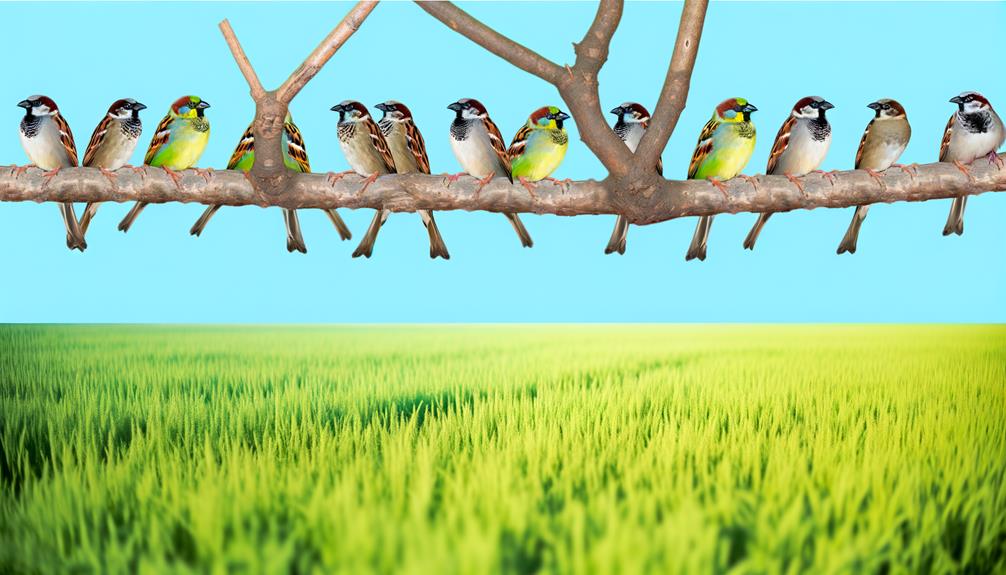
Key Takeaways
- A field guide to sparrows would include identification tips, such as observing their stout body, round head, and distinct plumage.
- The guide should cover common species like the House Sparrow, Song Sparrow, and White-throated Sparrow, detailing their unique traits.
- Information about sparrow habitats, including preference for ground cover and open spaces, is essential in a field guide.
- The guide should explain sparrow calls and songs, which vary across species and are crucial for communication and mating.
- A comprehensive field guide would also discuss sparrow migration patterns, threats they face, and conservation efforts.
Understanding Sparrow Basics
To truly appreciate sparrows, one needs to explore their fundamental characteristics such as their size, habitat preferences, feeding habits, and distinctive songs.
Sparrows are small birds, usually measuring between 11.5-18 cm in length, and are found worldwide, excluding the Polar Regions. They thrive in diverse habitats, from urban areas to farmland and forests.
Sparrows are omnivorous, their diet typically consists of seeds and insects. They're not picky eaters and adapt their diet according to the season.
Additionally, each sparrow species has its distinctive songs, varying in rhythm and pitch. These songs, often described as a series of cheeps or chirps, are primarily used for communication, including attracting mates and defending territory.
The Sparrow's Physical Characteristics
What sets sparrows apart in the bird kingdom, you might ask? It's their distinct physical characteristics: a stout body, round head, short tail, and strong beak designed for eating seeds.
These small, plump birds usually sport brown or grey plumage, with males often exhibiting darker, more vibrant colors and distinctive markings. Their wings are short but powerful, built for swift, agile flight.
Sparrows are typically between 11 to 18 cm in length, and their weight can vary from 13 to 40 grams depending on the species. Their plumage is often streaked, providing an effective camouflage in their natural habitats.
Sparrows' eyes are sharp, fit for spotting potential threats or identifying different types of seeds. Their sturdy legs and feet, designed for hopping, complete their distinctive physique.
Common Sparrow Species
Diving into the diversity of the sparrow species, you'll find several common types populating different regions around the world, each with its unique traits and behaviors.
Among the most widespread, are the:
- *House Sparrow (Passer domesticus)*: These adaptable birds, with their black bibs and cheerful chirps, are often seen in urban environments, symbolizing resilience.
- *Song Sparrow (Melospiza melodia)*: Known for their melodious song, these sparrows evoke a sense of joy and harmony with their presence, usually found in open, shrubby, and wet areas.
- *White-throated Sparrow (Zonotrichia albicollis)*: With their distinctive white throat patch, these birds stir admiration for their striking appearance and love for dense vegetation.
Each species has its charm, contributing to the rich tapestry of our global ecosystem.
Uncommon Sparrow Species
While the House, Song, and White-throated Sparrows are often sighted, there's a whole suite of less common sparrow species that are equally fascinating, each with their unique characteristics worth exploring.
Consider the Fox Sparrow, with its vibrant russet plumage, or the Golden-crowned Sparrow, identified by its striking head markings. Then there's the secretive Grasshopper Sparrow, named for its insect-like song, and the Bachman's Sparrow, a bird of the southern pine forests.
| Species | Unique Characteristic |
|---|---|
| Fox Sparrow | Vibrant russet plumage |
| Golden-crowned Sparrow | Striking head markings |
| Grasshopper Sparrow | Insect-like song |
| Bachman's Sparrow | Southern pine forest dweller |
Each species presents a unique opportunity for observation and understanding, offering insight into the rich diversity of the sparrow family.
Sparrow Habitat Explained
Sparrows, in their natural environment, exhibit a preference for certain habitat features, which have a major influence on their survival and reproductive success.
The specific characteristics of these habitats, ranging from vegetation type to availability of food sources, play an essential role in shaping their distribution and behavior.
However, human activities have begun to impact these habitats, leading to shifts in sparrow populations and raising concerns for their future survival.
Understanding Sparrow's Natural Environment
Though they're often seen in urban and suburban areas, sparrows, in their natural environment, are typically found in open landscapes like deserts, grasslands, or forests, with a clear preference for areas abundant in seeds and insects. They've adapted to these environments over millions of years, developing behaviors and characteristics that help them survive and thrive.
To bring a sense of the sparrow's natural setting to mind, consider the following:
- The lonely echo of a sparrow's song across the quiet expanse of a desert.
- The flutter of wings amidst tall prairie grasses under endless skies.
- The sudden rustle as a sparrow flits between branches in a dense, dappled forest.
Understanding the environment of sparrows helps in appreciating these stout, chirpy birds and their integral role in our ecosystems.
Sparrow's Preferred Habitat Features
Building on the understanding of the sparrow's natural environment, it's important to unpack the specific features these birds look for when choosing a habitat. Sparrows typically prefer habitats with plenty of ground cover, such as grasses and bushes, which provide protection from predators and harsh weather.
They're also partial to areas with adequate food sources, like insects, grains, and berries. Open spaces for flight and tall trees or structures for nesting are also vital. Water availability, particularly freshwater sources, plays a significant role too.
Sparse human activity is preferred, but they've adapted to urban settings. However, each species has nuances in habitat preferences, underscoring the need for species-specific conservation strategies.
Human Impact on Sparrow Habitats
Human activities have greatly altered the natural habitats of sparrows, leading to a range of impacts on their survival and distribution. Urban expansion, agriculture intensification, and pollution are just a few factors that have fragmented and destroyed suitable habitats for sparrows.
Urbanization replaces natural habitats with buildings and roads, reducing the availability of food and nesting sites for sparrows.
Agriculture intensification often involves the use of pesticides, which can contaminate food sources and directly harm sparrows.
Pollution, particularly air and noise pollution, can disrupt sparrows' communication and breeding behaviors.
As habitats become increasingly unsuitable, sparrows are forced to adapt or relocate, leading to shifts in their geographical distribution and potential declines in their overall population.
Sparrow Diet and Feeding Habits
Sparrows, with their diverse diet, primarily feed on seeds, but they're also known to consume insects and other small invertebrates, particularly during breeding season. They're often observed scouring the ground, flitting from one spot to another, their sharp beaks picking up tiny morsels with remarkable precision.
They've adapted to various habitats, including urban environments, where they'll consume human food scraps. Seasonal changes affect their diet too. In colder months, sparrows rely heavily on seeds and plant materials. They've an interesting feeding habit: they scratch the ground with their feet in a backward motion, a technique known as 'double-scratch', to uncover hidden food.
Despite their size, sparrows have a voracious appetite, which helps them survive in diverse environments.
Sparrow Breeding and Nesting Patterns
In the domain of avian reproduction, sparrows exhibit fascinating breeding and nesting patterns that are meticulously designed to bolster their survival rates. They're monogamous, typically pairing for life, and both partners actively engage in the nest-building process. Nest sites vary greatly depending on the species, but most favor sheltered areas, such as tree hollows or under eaves.
Their nesting behavior stirs a sense of admiration:
- Sparrows utilize a variety of materials for their nests, from grass and twigs to human-made objects, reflecting their adaptability.
- Both parents share in incubating the eggs and feeding the young, showcasing their commitment to family.
- The rapidity of their breeding cycle, often producing several broods in a season, reveals their tenacity in the face of adversity.
The Sparrow's Unique Calls and Songs
Delving into the domain of avian communication, one can't help but marvel at the distinct calls and songs of sparrows, serving not only as a means of communication but also as unique identifiers specific to each species. They have a rich repertoire of sounds, from melodious songs to harsh chirps.
For a quick reference, let's consider the table below showcasing calls and songs of four common sparrow species:
| Species | Call/Song |
|---|---|
| House Sparrow | Short and incessant chirping |
| Tree Sparrow | A sweet, high-pitched 'cheep' |
| Song Sparrow | A complex, melodious song |
| Fox Sparrow | Rich, whistling notes |
It's clear that each sparrow's call or song is an intricate blend of nature and nurture, carefully crafted over generations, and instrumental in their survival and mating strategies. Truly, the sparrow's symphony is as unique as it is universal.
Sparrow Migration Patterns
Observation of sparrows has revealed distinct seasonal movements, with certain species exhibiting migratory behavior. These migration patterns are largely influenced by factors such as climate, food availability, and breeding conditions.
These patterns are an important aspect of sparrow ecology. A thorough understanding of these movements is crucial to further study and conservation efforts for this versatile bird species.
Seasonal Sparrow Movements
While many species of sparrows remain in the same region year-round, others undertake extensive seasonal migrations, exhibiting fascinating patterns that have intrigued ornithologists for decades. Some species journey thousands of miles between breeding and wintering grounds, exploring vast landscapes with remarkable precision.
Seasonal migration, a spectacle of nature, evokes several emotions:
- Awe at the sheer distance these small creatures travel.
- Curiosity about the inherent orientation skills they possess.
- Appreciation for the resilience they show in the face of natural elements.
Detailed studies have revealed various types of movement patterns. Some sparrows exhibit complete migration, moving between distinct summer and winter ranges, while others show partial migration, with only some population members migrating. These different strategies paint a complex, intriguing picture of sparrow life.
Factors Influencing Migration
Exploring the factors that influence these migration patterns can shed light on the intricacies of sparrow behavior and survival strategies. Primarily, sparrows' migration is driven by environmental conditions, such as temperature and food availability.
These birds are highly adaptable, adjusting their migratory patterns based on seasonal changes. When winter approaches and food resources dwindle, sparrows migrate to warmer regions with abundant supply.
Another key factor is their biological clock, an innate mechanism that prompts their departure and return. Certain light triggers can stimulate this internal clock, signaling the sparrows to begin their journey.
Threats and Conservation of Sparrows
Sparrows' survival is increasingly threatened by various factors such as habitat destruction, pollution, and climate change, mandating urgent conservation efforts. Human activities, especially urbanization, destroy their natural habitats, leaving them vulnerable.
Pollution, specifically pesticides, contaminates their food sources, causing lethal poisoning. Climate change disrupts their migration patterns, leading to population declines.
The sight of a sparrow struggling to survive in a polluted environment is heartbreaking. Sparrows displaced from their natural habitats due to urbanization paint a poignant picture of their struggle. Climate change's harsh impact on sparrow migration is deeply concerning.
Thus, conservation efforts are crucial. Protecting their habitats, reducing pollution, and mitigating climate change can help guarantee these delightful birds continue to grace our skies.
Attracting Sparrows: Tips and Tricks
Despite the challenging threats facing sparrows, there are effective ways to attract these charming creatures into our gardens and backyards.
To start, providing ample food supply is key. Sparrows are primarily granivores, so a bird feeder stocked with millet or sunflower seeds is highly appealing. Additionally, sparrows need access to clean water for drinking and bathing. A shallow bird bath serves this purpose nicely.
Habitat is equally important. Sparrows favor dense bushes and shrubs for nesting and hiding from predators.
Conclusion
To sum up, sparrows may seem ordinary, but they're a fascinating study. They've adapted to diverse habitats, developed unique calls, and exhibit intriguing migration patterns. Their survival, despite environmental threats, attests to their resilience.
So, next time you're outside, take a moment to appreciate these remarkable birds. Who knows? You might find yourself compelled to test the theory that attracting sparrows can enhance the biodiversity of your own backyard. It's a small step towards sparrow conservation, and every little helps.

